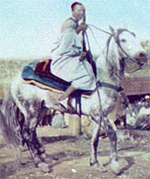If there is one thing that we have learned from working with Teaching American History (TAH), it is that there is an abundance of information from which teachers can draw to create lesson plans. But, that does not mean that all teachers jump at the chance to craft new units, nor does it mean that such lessons are all equal. In this piece I will discuss the diverse outcomes of these processes through the examination of the work of teachers who will represent "types" that our TAH team has encountered repeatedly. They are (1) the eager, good, young teacher; (2) the engaged, creative, seasoned teacher; (3) the unchallenged veteran who eschews change; (4) the bored veteran who welcomes a challenge, and finally (5) the non-history teacher who uses new history content in impressive interdisciplinary ways.
While there are many teachers who fall outside of these profiles, or who straddle more than one, these categories will allow for a discussion of what you might encounter and how you can see the possibilities of each—and to try to use them to your grant's advantage. But this essay is not just about the content of lesson plans, though we all know that the content is the focus of our grants. This essay will look at the ways that being a successful history teacher also necessarily involves being an engaged teacher, and realizing that in these grants, putting teachers in the role of students can have brilliant consequences when mixed with new content.
There is an abundance of information from which teachers can draw to create lesson plans. But, that does not mean that all teachers jump at the chance.
Starting Strong
Teacher Number One (1) is a fifth-year middle school teacher in an urban fringe school district. He has a bachelor's degree in history and secondary education. He decided to participate in our TAH grant in its second year because he hoped to help his tech-savvy students make a stronger connection between today's technology and the machines of yesteryear. Teacher No. 1 crafted a well-organized, meticulously arranged unit plan that merged in-class work and homework assignments beautifully. He capitalized on sophisticated technology and clearly addressed national standards in both history and historical thinking.
The national standards addressed in the unit cover the factory system, urbanization, economic concepts in global contexts and how technology has changed people's lives. The primary objective of this unit was to compel students to understand the effects that technology and industrialization had on the lives of everyday people in Rhode Island. Ultimately, the teacher hopes that this unit will produce a discussion of how technology affects peoples' lives today.
The student work produced from Unit No. 1 was primarily journal-based and also asked students to fill in pre-made graphic organizers. All of this work was related to the textbook and an impressive PowerPoint presentation, created by Teacher No. 1, on the Industrial Revolution—with a viewer's guide to go along with it. Perhaps the most engaging activity in the unit was a mock town meeting at which students were assigned the roles of people who lived in the area when Samuel Slater was planning his mill in Pawtucket, RI in 1793. These roles included a fisherman, farmers, small mill owners, a local farming family, and a church group. Each group was given extensive background information and was guided through the process with fill-in-the-blank forms. (This works well at the middle school level, but one can see that it could be easily adapted to a high school classroom.) Lastly, the groups were given multiple primary documents to help their cases and prepare them for the unit's culminating activity: a visit to the Slater Mill Historic Site.
A Second Approach
Our second teacher is an 11th grade U.S. history teacher in the same district as our first. Although she has only been teaching for two more years than Teacher No. 1, teaching is a second career for her after receiving a bachelor's degree in public policy and a master's degree in education. While dedicated to her students, her reasoning behind signing up for our TAH course was that she wanted to keep up with the latest historiography and keep her teaching fresh. Even though at first this might appear to be the more selfish of the two responses to the question of why they wanted to learn more, I have come to believe that this is actually the educational equivalent of putting the oxygen mask on yourself first, and then helping others on the plane. She was not being selfish by focusing on her herself; she was recognizing that for the good of the students, she needs to stay up to date in the field.
. . . this is actually the educational equivalent of putting the oxygen mask on yourself first, and then helping others on the plane.
Teacher No. 2's unit plan was exhaustive and written in a wonderful tone that she chose, successfully, to be easily adaptable to other classrooms and other levels. It was well integrated into the overall college prep curriculum and took the students' graduation requirements into account. Moreover, Teacher No. 2 included all of the same technology as Teacher No. 1, as well as incorporating traditional, hands-on projects in engaging and effective ways.
Teacher No. 2's unit plan outlined an original goal to have the students read a monograph, often assigned at the college level, to better grasp the character of America at the beginning of the Industrial Revolution. From the outset, therefore, Teacher No. 2 has engaged the ideas stressed in our institute and readings: that for our students to better relate to history, they should learn not to apply their own standards and ideologies to past actors, but instead learn about the philosophies of prior periods.
The teacher then guided her students through the traditional "Now and Then" essay, but with a twist: students were not asked to see the past in light of the present, but were urged to see each for its own merits, related, but not dichotomous. In a very fluid fashion, the unit covered the evolution of an agrarian society to an industrialized one, focusing on the need for workers in the 19th century, and moving up to related immigration issues today. The teacher used PowerPoint presentations to supplement her lectures, discussions, and activities, while the students used more traditional, yet still dynamic, hand-on processes, like essays, posters, and life-sized painted depictions of peoples from immigrant cultures.
Working Together
Both the units of Teachers Nos. 1 and 2 have much to offer students in the same content area, and represent teaching one time period and topic to diverse grade levels. But, what could these two unit plans gain from each other? And would these lessons be applicable to the other teacher's grade level? After reviewing countless units, I would suggest that even at the middle school level, students could handle more formal writing than is incorporated into the lessons in Unit No. 1. Although the students were producing journals and filling in blanks, the arguments that they crafted for their mock town meeting were done in groups. Individuals could have been asked to write their own arguments independently and start to learn the skill of developing a thesis and proving it in an historical essay.
Teachers have not just high expectations for their classes, but also for themselves. They instilled their own creativity into their lessons, lectures, and unit designs.
Similarly, while the high school students were asked to write both essays and create art-based projects, they could also have been asked to present their cases orally. Especially at the upper level, where writing and test-prep are so often the focus, it is just as important for students to get practice articulating themselves in speech—particularly on such hot topics as immigration. Remember, we are not just trying to prepare our students for tests or more schooling, but for a civic life in which each can feel comfortable participating in public discourse. Both of the aforementioned units have the potential, if used properly, to prepare students for success in both school and their communities.
The Uphill Climb
It is clear that both of the first two teachers have not just high expectations for their classes, but also for themselves. They instilled their own creativity into their lessons, lectures, and unit designs. Often history teachers have to retain their own expectations in the face of school administrations that have little time for the untested social studies, especially history. Our third teacher, who is part of a high-performing history department in an urban-fringe high school, seems to have allowed the lack of state focus on history to lower his own expectations. Quite shockingly, in this teacher's mandatory reflection piece, he admitted that this was the first lesson plan he had been asked to create in 20 years. And, after that statement, he added that he knew that it was not his best effort.
In this unit he borrows, frequently, from previously created materials. Borrowing, of course, is fine—in fact, we encourage taking from the excellent materials that are already out there. But, if you are going to borrow, you should make sure that you get the information correct and that you add to its quality, not detract from it. The unit produced by this educator gave students incorrect information about the slave trade, in particular the Triangular Trade (an important topic, especially in Rhode Island). The student work that said teacher submitted reflected this misinformation. Moreover, the students who produced factually specious (and sometimes outrageous) materials were not graded down for it. Despite feedback sessions with other teachers, opportunities for resubmission, and a chance to try again the next year, Teacher No. 3 decided to opt out of all future participation.
A Success Story
Not every teacher who confronts the difficult situation of realizing that he has produced sub-par materials, however, backs away from the challenge. In point of fact, one of our greatest TAH success stories is a history teacher in a low-performing urban district in which he often finds himself teaching ESL students and those with striking learning differences.
Teacher No. 4, also a veteran teacher, is popular with his students, and in the summer institute was enraptured with the new information he was learning. Yet, in the fall, when he turned in his unit plan, it was, in laymen's terms, a mess. It did not follow standards of any kind and sections were handwritten, not proofread, and did not build to any sort of culminating activity.
When confronted with the work of other teachers in his group, and with my comments as his professor, he seemed shocked and deeply saddened. This began an all-out onslaught to create a better unit and, to paraphrase his own words, to become a better teacher. He consulted with me and the Rhode Island Historical Society's TAH coordinator for materials and teaching strategies. He tried new, online resources. He ended up retooling his unit plan and resubmitting it. It was not perfect, but it was enough to take him from an F to a B. But more importantly than that, it reinvigorated his teaching just to have other people care about his work and expect more of him.
In the next year, the third and final of the grant, Teacher No. 4 was back with even greater energy to learn and perform. Unlike any of the other 40 teachers, he contacted me within a week of the institute to help plan a better unit. He had gotten one of the deepest messages of the TAH grant program: there are countless resources out there waiting to give you help—you just have to ask. No teacher can know everything, so when resources present themselves, grab them and use them.
. . . there are countless resources out there waiting to give you help—you just have to ask.
When Teacher No. 4 turned in his next lesson plan, it was excellent. In fact, he was the only teacher in his district to receive an A for the course. His new approach showed not only in the content, but also in his presentation. His work became a model for other teachers, as did his attitude—one that took sincere joy in the challenge of doing his job better. He expected more of himself and his students, and ultimately, it is his students who will reap the benefits. The difference between Teacher No. 3 and No. 4 is not that one is smarter than the other, but that one was open to the idea of change and that even though he knew a lot, he could know more. He also embraced the idea that if he was ever to have high expectations for his students, he could not avoid them for himself.
Cross Training
We have reviewed the effect of increasing expectations on teacher-created lesson plans for history. As we all know, however, our TAH grants benefit greatly from the participation of non-social studies teachers, as well. Within most of our grants, we have hosted ESL, special education, ELA, and elementary school teachers. Thus, the fifth teacher in this essay is an English/language arts teacher in an urban middle school.
Since history is not her main content area, she was given the leeway to create a unit that she hoped would develop students' reading, writing, thinking, and language skills using the writing of King, Dunbar, Angelou, Hughes, and Walker. The historical content of the unit is clear, and this literature teacher clearly benefited from a week of intensive history training. Her unit elegantly illustrated the fact that texts can be used to help understand history, just as history can be used to help understand a text—and that such work can be used to strengthen what are typically thought of as ELA skills: reading, writing persuasively, and oral argumentation.
I am left, as a historian, however, with many questions: if those are not the skills used by a historian, then what are? What is it that keeps our schools from allowing, even requiring, history teachers to foster these skills in history classes? How can a state create standards for history that do not include persuasive writing?
Lessons Learned
This is a brief essay, and certainly it is one that contains as many questions as answers. I hope, however, that it demonstrates the importance of a willingness for all of us to learn from each other and the wide resources that these grants afford us. Excellent high school and middle school units on the same topics can still learn from each other. Teachers who are finding it hard to get into a groove can succeed it they are willing to ask for help. And history teachers can most certainly learn from other disciplines to make their K12 history classrooms more like their college counterparts. More than this, however, I hope this essay brings home the point that these institutes and seminars we hold, thanks to TAH funding, inform our teachers' lessons and classroom styles. This has a true, if unquantifiable, effect on our students.




